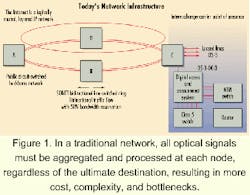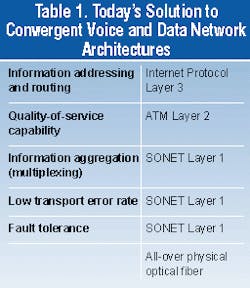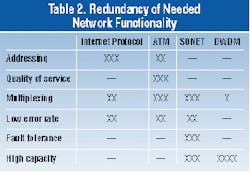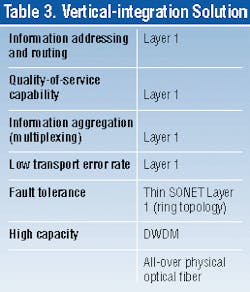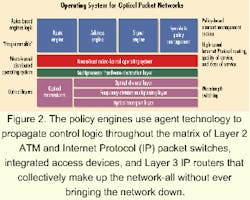Delivering a new vision for the 'limitless' optical Internet
New protocols and software are making today's Internet economy fertile ground for optical competitors with innovative technologies.
Gerald Ramdeen
Luxcore
With the Internet's growth continuing at breakneck speed, companies continue to redefine themselves to compete in the new Internet economy. As a result, they are conducting more and more business online. Used for everything from e-mail and faxing to Internet Protocol (IP) telephony and videoconferencing, today's Internet transactions have increased, requiring much more dynamic and flexible bandwidth allocation and longer connection times. Yet, today's circuit-switched legacy networks are engineered for symmetric voice traffic-an architecture that is not compatible with the exploding Internet usage model.
SONET, an optical transport layer technology designed to reroute and restore connections made over the communications network, currently transports over 95% of all fiber-optic traffic. Backbone networks, based on ring and linear transport models, move optical signals using SONET transport. However, this transport model loses its efficiency when optical signals move between rings or from one fiber network to the next.Signals must be electrically regenerated to maneuver through and to be processed by additional network elements in the electrical domain, such as SONET terminals, broadband digital crossconnects, ATM switches, and core terabit IP routers (see Figure 1). This process slows down the signals appreciably as rates slow down to STS-1 connections, or approximately 50 Mbits/sec. In effect, all optical signals must be aggregated and entirely processed at each network node, regardless of the ultimate destination of the traffic. The result is undue expense, complexity, and performance bottlenecks.
Connection-oriented networks reserve specific amounts of bandwidth for a fixed duration, such as the duration of a telephone call. Connectionless networks, in contrast, do not reserve bandwidth; bandwidth is used only when there is traffic to carry. So legacy connection-oriented telephone networks designed for transporting circuit-switched voice traffic currently transport connectionless IP data traffic. This approach is neither efficient nor successful.
IP traffic, in contrast to voice traffic, sends "packets" of data across the network in a bursty and unpredictable manner on a "best efforts" basis. This IP traffic model reserves circuited-switched resources and requires operators to invest significant capital in additional hardware and fiber capacity (bandwidth) to provide reasonable grades of service.With estimates that by 2010 over 90% of all Internet traffic will be between machines, a circuit-switched network will not efficiently allocate enough bandwidth to handle this volume of traffic without an astronomical investment in additional bandwidth for over-allocation. However, the telecommunications industry strives to maintain the reliable quality of service (QoS) we've come to expect from connection-oriented networks. Therefore, the objective of optical-network designers is to put IP over glass and achieve the QoS associated with connection-oriented telephony networks, while realizing the bandwidth efficiencies of IP connectionless networks.
The solution to this inefficiency is the creation of an optical Internet-an all-optical network with the following fundamental characteristics:
- Elimination of the electrical regeneration of optical signals.
- Wavelength management at varying levels of optical bandwidth granularity with varying optical-switching speeds.
- Increased optical-fiber utilization (optical statistical multiplexing).
- QoS mechanisms equivalent to those of connection-oriented networks.
This approach will ultimately provide operators with the benefits they are looking for, such as increased bandwidth utilization, lower costs, and new services. Yet, much of the industry's current focus is only on removing electronics from the optical transport layer. With that being the single goal, there is no separation of optical control information from optical data payload, thus transparent optical switches are limited to basic crossconnect functions. Routing and path construction become the responsibility of edge devices.
There are substantial issues with this model that raise the following questions: What if the control information contains special routing instructions that impact circuit path throughout the core? How does the system prevent a wavelength blocking condition when two or more of the same wavelengths (carrying different customer traffic) compete for the same output fiber? How is this control information communicated and processed within the all-optical network?
When looking beyond simple removal of electronics from the transport layer, new possibilities emerge. For example, control data and the payload are kept in the optical form, but there exists encoding and decoding techniques that allow the photonic wavelength router or photonic packet switch to separate control information from the payload data.Using optical performance monitoring, network topology, active and passive optical subsystem state information, and user/application requests as input, wavelength routing systems process control information to make real-time switching decisions throughout the network. This control information must be optically captured, encoded, extracted, and distributed. All critical functions-reading optically encoded information (optical packet data units, or OPDUs), routing, switching, forwarding, adding, and dropping optical signals-are done at multiterabit rates and nanosecond optical-switching speeds.
The processing of these optically encoded OPDUs, combined with traffic engineering, results in intelligent optical bandwidth management that provides optical bandwidth whenever, wherever, and in whatever amounts necessary. That is the essence of a photonic (all-optical) wavelength router. To build such a system, a new type of software architecture is required. It is at this point that software becomes the partner to optical hardware.
Another fundamental requirement for the creation of the optical Internet is to elevate ring and linear transport, thus completing optical mesh network architectures. Switches, along with transport and network-management systems, are combined into fully protected, communicating, and collaborative all-optical multiwavelength or optical bandwidth management systems. These networks can be organized into numerous logical architectures, permitting more flexible configurations that support different traffic and protection requirements across large metropolitan and core networks. They also allow carriers to dynamically allocate wavelengths for optimum network efficiency and allow access to the protection bandwidth normally reserved in SONET systems.
When establishing an optical Internet, optical IP routing, switching, and transport will require technologies that support optical packet routing and forwarding operations at multiterabit speeds equal to the fastest DWDM transmission speeds. Accomplishing this feat requires functionality that is typically found at other layers of the network. Table 1 illustrates how most network architectures are designed to have a layer for each networking function. Because of the redundancy in basic software-driven functionality across the network layers, today's networks are too complex and costly to achieve the goal of matching optical packet routing and switching performance with DWDM transmission (wire) speeds. This structure also leads to sluggish decision-making times that are outside of the optical delay technologies required to process control information in the optical domain.
Table 2 highlights the Open Systems Interconnection (OSI) layer protocol redundancy that needs to be eliminated in order to streamline the decision-making process in the optical domain. Streamlining can be achieved by implementing an ATM-centric traffic engineering model that combines Multiprotocol Label Switching (MPLS) and open-shortest-path-first (OSPF) routing.
MPLS and OSPF provide information for route lookup, bandwidth management, traffic management,and photonic packet switching and routing, allowing the integration of IP packet routing, forwarding, and switching functionality directly into the DWDM optical layer. The result is flexible upgrade capabilities, scalability, protocol independence, and bit-rate transparency.
With the ability to handle unpredictable data traffic, optical mesh networks will have core photonic switches, or optical crossconnects (OXCs), that shift intelligence throughout a distributed network of photonic wavelength routers-some equipped with dynamic optical add/ drop capabilities, photonic packet switches, and ultra-long-haul transport capability. While core IP routers perform access and aggregation of IP services today, greater degrees of optical bandwidth granularity, restoration, optical path routing, and fast switching speeds will be performed in these complex mesh networks.When all of those considerations are taken into account, the new architecture must be based on the concept of a "collapsed" OSI stack, where routing and switching functions are directly engineered into the optical transport layer, as represented by the vertical integration shown in Table 3. Collapsing the number of network layers increases backbone throughput, thus removing congestion while making the most optimal and efficient use of optical-fiber transport technologies. This new optical transport layer will take on new intelligent network capabilities as QoS and service-level agreements (SLAs) are unleashed by increased bandwidth.
This "de-layering" also has two distinct advantages: First, Moore's Law is no longer a factor in the control of network architecture and engineering design; second, with the advent of connectionless optical statistical multiplexing, optical fiber becomes a variable as opposed to a fixed cost. The solution is optimally suited for IP and WDM technologies, because these areas are experiencing the highest price/performance growth rates per year at 52% and 130%, respectively.
In this new architecture, photonic wavelength routers with programmable optical add/drop multiplexers, intelligent OXCs, and photonic packet switch routers will come to the forefront-driven by a new class of operation system software. This new architecture affords the benefits of all-optical subsystems, namely bit-rate transparency and protocol agnosticism. Hardware will not need continual upgrading as in current architectures. As software begins to take on a greater role in everything from modulating frequencies to determining what wavelengths to add and drop, the need for new hardware is dramatically reduced, thereby speeding time-to-market.
The vision of an optical Internet demands that a "second-generation network" be created-a network supported by a set of products enabling the first full-service, end-to-end, continuously upgradable communication system. One approach is a distributed network architecture (DNA), an Internet-based command and control system based on self-provisioning service-delivery architecture. This approach mirrors the engineering design of the public-switched telephone network (PSTN), which is divided between an out-of-band signaling network (Signaling System 7-SS7) and is responsible for call processing and a circuit-switched transport network for voice and data transport. However, one such product, NeuroTrust DNA by Luxcore, utilizes specialized hardware.
Unlike the PSTN, NeuroTrust DNA is a packet data network optimized for real-time voice traffic. The control logic is distributed throughout the network. It is continuously upgradable because the "smarts" are programmed throughout the network by software in an advanced "plug-and-play," high-transaction-enabled, enterprise framework of distributed databases and policy engines.
Network "behavior" is controlled by collections of user-, administrator- and system-defined policies stored throughout the wide-area private Intranet of distributed mega-points of presence (megaPoPs)-usually one per metropolitan statistical area. Policies maintain data that instructs the network on everything-from rules for dynamic bandwidth allocation to user and application security profiles and enhanced service customization by individual subscribers. As policies change over time, so will the behavior of the network. MegaPoPs manage a distributed higher level (Layer 4) network of cooperating policy (rules) engines that change network behavior based on those policies.This network design is standards-agnostic, meaning that if the session initiation protocol (SIP) surpasses H.323 as the new call setup protocol for voice over IP, we simply replace the H.323 signaling engine and associated database (coded rules) with the new SIP signaling engine and associated database of rules. The policy engines use agent technology to propagate control logic throughout the matrix of Layer 2 ATM and IP packet switches, integrated access devices, and Layer 3 IP routers that collectively make up the network-all without ever bringing the network down (see Figure 2).
Subscribers (users, channel partners, system administrators) access the service-control functionality via a telecommunications company Web portal that acts as the single common interface to all online services and programmable service-control logic. In its first stage, system administrators set the policies on behalf of their customers. In its second stage, consumers will use the portal to "program" their own designer-enhanced services.
The same distributed network architecture and Web portal that controls communication services is also a service creation platform. Using the NeuroTrust DNA object model and application programming interfaces, a service provider, its partners, and its subscribers can implement and bring to market (self-provision) new enhanced services and broadband communications, messaging, and information-exchange applications faster.
More and more hardware is not enough to solve today's bandwidth restraints. The optical Internet can deliver on the promise of limitless speed and bandwidth by establishing new protocols and software. The new protocols will collapse the first four layers of the OSI stack down to one, and new software systems will rapidly process control information necessary for routing and restoration.
These new systems will enable entire new classes of services that thus far have been impossible to implement. As a result, the vision of an Internet with no more bandwidth bottlenecks can ultimately become a reality.
Gerald Ramdeen is chairman and CEO of Luxcore (Atlanta).

